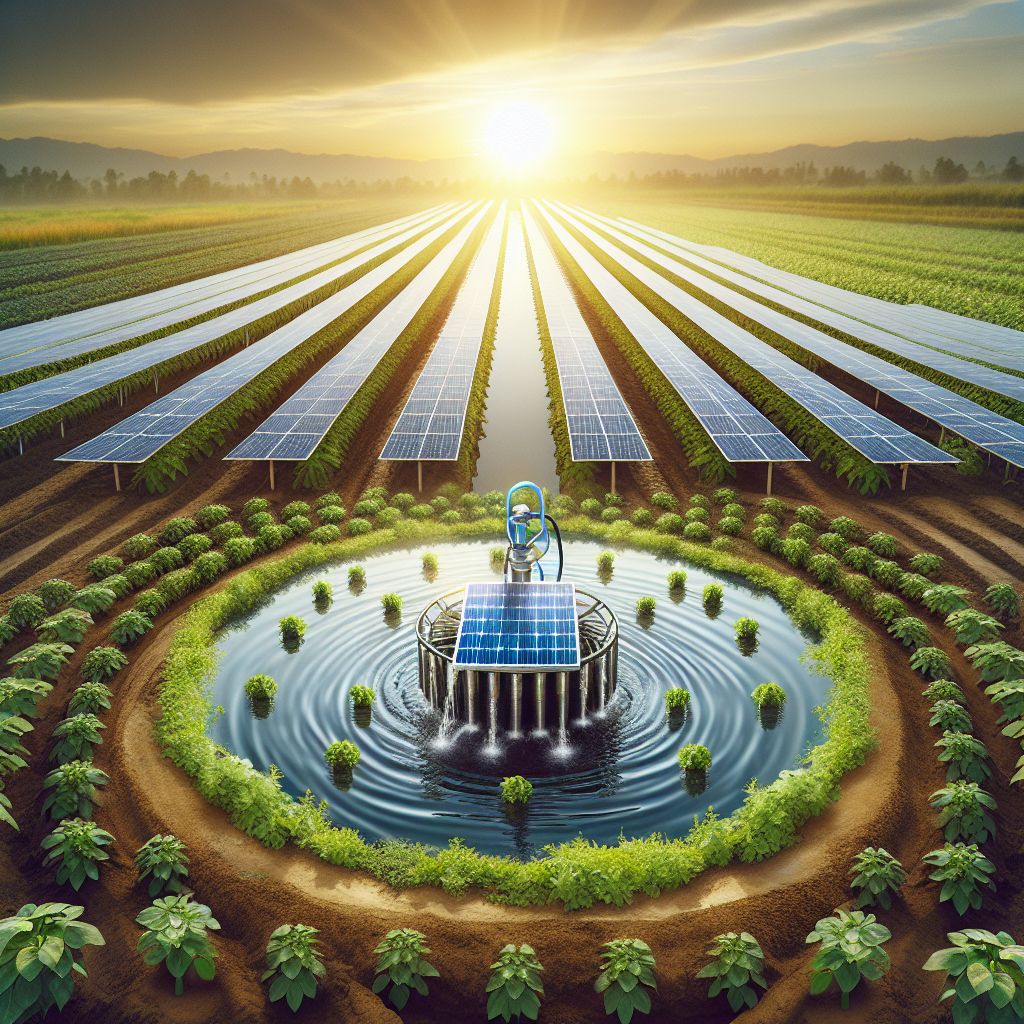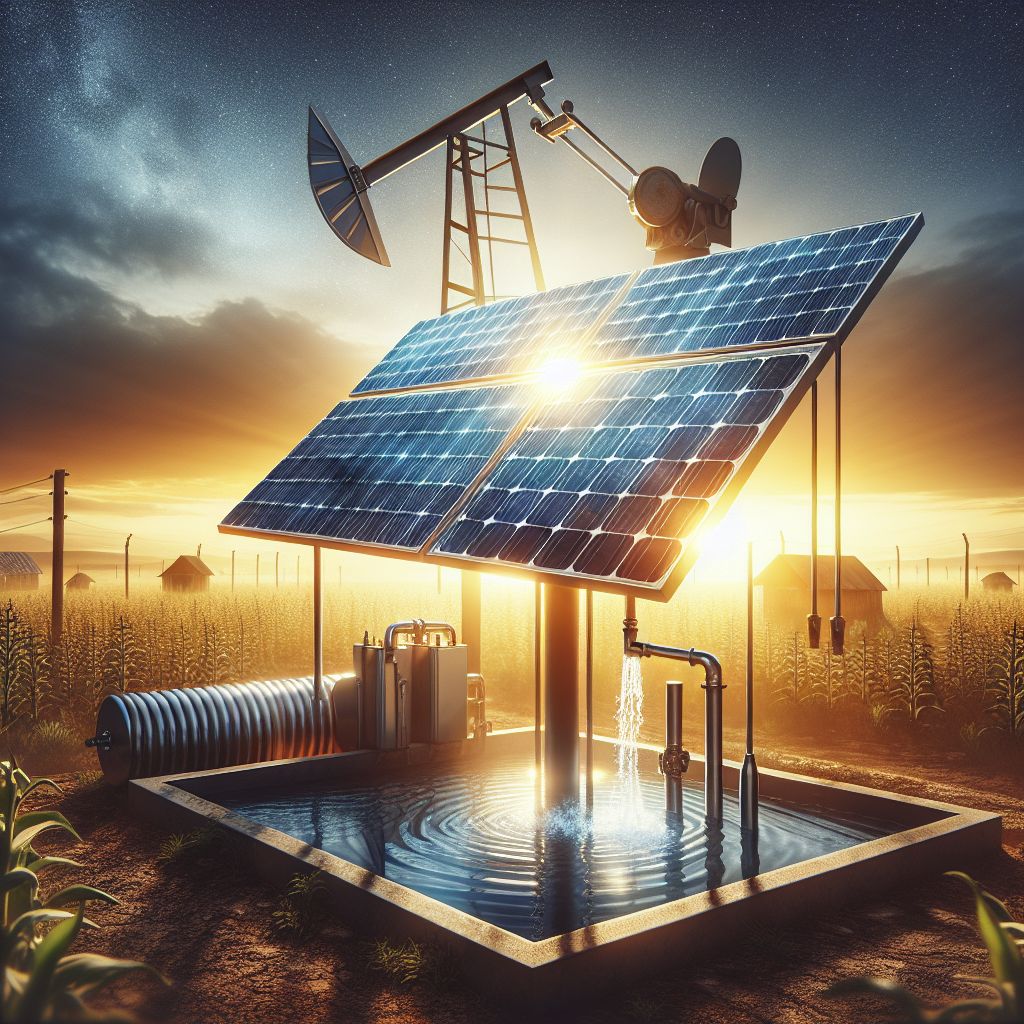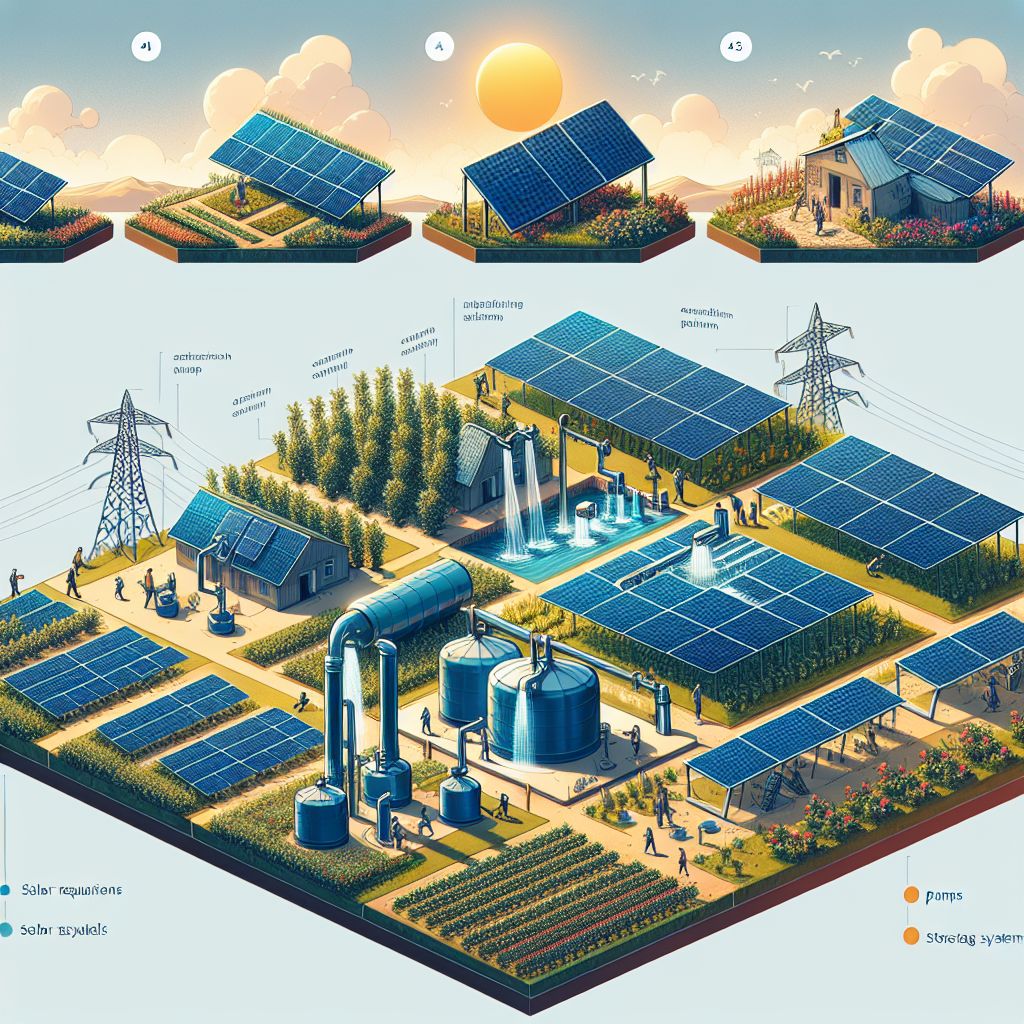
Key Takeaways
-
Solar submersible water pumps are a cost-effective and eco-friendly irrigation solution for farmers.
-
They operate efficiently at great depths and are well-suited for areas with abundant sunlight.
-
Switching to solar pumps can significantly reduce a farm’s energy bills and carbon footprint.
-
Even during cloudy weather, solar pumps can still function effectively with proper battery backup systems.
-
Investing in solar pump technology can lead to higher crop yields and increased profitability.
Soak Up the Sun: How Solar Pumps Revolutionize Farm Watering
Imagine a farm where the power of the sun not only nurtures the crops but also draws water to them. This isn’t a dream—it’s a reality made possible by solar submersible water pumps. These ingenious devices harness solar energy to provide a consistent water supply, ensuring that even the most remote farms can thrive. Let’s dive into what these pumps are and how they’re changing the game for farmers worldwide.
What Are Solar Submersible Water Pumps?
Solar submersible water pumps are exactly what they sound like: they’re pumps that sit below the water’s surface, powered entirely by the sun. They consist of a solar panel array, a controller, a pump, and sometimes a battery for storing energy. These components work together to lift water from deep within the ground or from other water sources, delivering it to fields and crops without relying on conventional electricity or fuel.
The Benefits: Why are Farmers Turning to Solar Water Pumps to Irrigate their Farms?
One of the great things about solar water pumps is their scalability. Whether you’re tending to a small vegetable garden or overseeing vast fields of grain, there’s a solar solution that fits.
-
For small operations, a single panel might suffice.
-
Mid-sized farms may require a multi-panel setup.
-
Large agricultural enterprises could benefit from an extensive array of panels linked to high-capacity pumps and storage systems.
But scalability isn’t just about the size of the system—it’s also about adaptability. As farms grow and water demands increase, solar systems can be expanded with additional panels and batteries, ensuring that water supply keeps pace with farm development.
Most importantly, solar pumps are not a one-size-fits-all solution. Each farm is unique, and systems should be tailored to meet specific needs. A detailed analysis of water requirements, sunlight patterns, and crop cycles is essential for designing an efficient solar irrigation system.
Farmers are often at the mercy of unpredictable weather and fluctuating energy costs. Solar submersible pumps offer a level of independence and predictability that traditional water sources can’t match. Here’s why they’re catching on:
| Benefits | Description |
| Cost-Effective Solution | – Solar pumps offer a cost-effective solution for farmers, reducing reliance on grid electricity and minimizing operational costs. – They provide a sustainable and affordable energy source compared to traditional pumps. 4 |
| Reliability and Sustainability | – Solar pumps rely on sunlight, providing a reliable energy source for farmers in areas with unreliable or no electricity. – They are sustainable alternatives to regular pumps, requiring minimal water resources and reducing water waste. 4 |
| Environmental Benefits | – Solar-powered pumps are environmentally friendly, producing no emissions and having little to no carbon footprint. – They contribute to reducing the environmental impact of farming practices. 4 |
| Versatility and Multitasking Capabilities | – Solar pumps are versatile tools that can be used for various tasks like irrigation, watering livestock, and spraying crops. – They offer an all-in-one solution for farmers needing sustainable and cost-effective water pumping solutions. 4 |
| Income Generation and Government Support | – Farmers can sell surplus energy generated by solar pumps to the grid, providing an additional income source. – Government schemes like Pradhan Mantri Kisan Urja Suraksha Evam Utthan Mahabhiyan (PM-KUSUM) support the installation of solar pumps for energy security and income generation. 5 |
| Improved Productivity and Quality of Life | – Solar water pumps have the potential to improve yields and livelihoods of smallholder farmers, positively impacting productivity and quality of life. – They offer a sustainable solution for enhancing agricultural output. 2 |
The above table highlights the various benefits that solar water pumps offer to farmers, ranging from cost-effectiveness and reliability to environmental sustainability and income generation opportunities
Let’s talk numbers. While the upfront cost of a solar water pump can range from a few hundred to several thousand dollars, the long-term savings are substantial. For example, a solar pump system might cost $2,000 upfront, but it could save a farmer $500 per year on fuel and maintenance, paying for itself in just four years. Plus, there’s the added benefit of not being subject to fuel price volatility.

Quenching the Fields: The Efficiency of Solar Pumps
Efficiency is the name of the game when it comes to solar pumps. They convert sunlight into electrical energy, which is then used to power the pump motor. This direct energy transfer means that very little power is wasted, and water can be pumped throughout the day when the sun is shining.
Most importantly, the efficiency of a solar pump is determined by its photovoltaic (PV) panels. These panels capture sunlight and convert it into electricity. The more sunlight they capture, the more water can be pumped. This is why solar pumps are particularly well-suited to regions with high solar insolation—the amount of sunlight that reaches the ground in a given area.
As an example, a farm located in a sunny region like Arizona can expect their solar pump to operate at peak efficiency due to the state’s high solar insolation values.
Slash Your Bills and Carbon Footprint
It’s clear that solar pumps can slash energy bills, but their environmental benefits are just as impressive. By eliminating the need for diesel or electric-powered pumps, solar pumps reduce greenhouse gas emissions and air pollution. This not only contributes to a healthier environment but also aligns with global efforts to combat climate change.
Where the Sun Shines: Best Situations for Solar Pumps
Solar pumps shine brightest in areas where sunlight is abundant and electricity is scarce or expensive. They are ideal for remote locations where connecting to the grid is not feasible. Additionally, in regions where electricity is unreliable, solar pumps provide a consistent water supply, ensuring that crops are watered without interruption.
When the Sun Does Not Shine: Turn to Your Battery to Keep Your Pump Working
But what about when the sun isn’t shining? That’s where batteries come in. A solar pump system with a battery backup can store excess energy produced during sunny periods, which can then be used to keep the pump running during overcast days or at night. This ensures a consistent water supply, come rain or shine.
Therefore, while solar pumps are an excellent solution for many farmers, it’s important to consider the local climate and weather patterns when planning your solar irrigation system. A well-designed system will account for these variables, ensuring that water is available when and where it’s needed most.

A Deep Dive into the Mechanics
Understanding the mechanics behind solar water pumps is crucial to appreciating their value. The system may seem complex, but it’s built on a simple and robust premise. At its core, the technology captures solar energy, which is then converted into electrical power to run the pump. This conversion is a clean and direct process, leaving a minimal carbon footprint.
The efficiency of solar pumps is largely due to the photovoltaic cells in the solar panels. These cells are made from semiconductor materials, like silicon, which absorb sunlight and release electrons. These free electrons move through the material to produce direct current (DC) electricity. The DC electricity is either used immediately to power the pump or stored in batteries for later use, ensuring a consistent water supply.
The Components: Building a Solar Water Pump System
Let’s break down the components of a solar water pump system in this below table:
| Component | Description |
| Solar Photovoltaic System | – Generates electricity using solar panels through the photovoltaic effect. – Absorbs solar photons and converts them into energy. – Main component of the system. – Array of solar panels. 1 |
| Water Pumps | – Draws water from a source for various applications like agriculture and irrigation. – Available in AC and DC power options. – Includes submersible pumps for lifting water from great depths. 3 |
| Inverters | – Converts direct current (DC) output into alternating current (AC) for powering electrical grids and off-grid networks. – Essential for powering electrical devices like water pumps. 2 |
| Controllers | – Maximizes pump performance by controlling the water pump operation. – Sets pumping schedules, turns the pump on or off, and helps extend the pump’s life. – Offers efficiency improvements like water sensors for low water levels. 1, 2, 3 |
| Batteries | – Deep-cycle batteries designed to store excess energy generated by the solar panels. – Provide power during periods of low sunlight or at night when solar power is not available. – Must be deep-cycle batteries, not standard car batteries 1, 3 |
These components play crucial roles in the functionality and efficiency of a solar water pump system, providing farmers with sustainable and reliable water pumping solutions.
Installing a solar water pump system is a step-by-step process that involves sizing the panels to match the pump’s power requirements, ensuring the charge controller is compatible with the battery storage, and selecting the right pump for the job. The inverter is an optional component, only necessary if the pump runs on AC power.
The Science: How Sunlight Transforms into Water Flow
The science behind solar water pumps is a beautiful synergy between physics and engineering. When sunlight hits the solar panels, it triggers the photovoltaic effect, which generates electricity. This electricity powers a motor within the pump unit, creating a mechanical force that pushes water through pipes and towards the crops.
It’s a seamless process that, from sunrise to sunset, provides a reliable water supply. And, because the energy source is as constant as the daylight cycle, farmers can plan their irrigation schedules with precision and confidence.
Real-Life Success: Stories from the Soil
There’s no better way to understand the impact of solar water pumps than through the stories of those who use them. Across the globe, farmers are reaping the benefits of this sustainable technology.
Growth in the Green: Farmers Who Made the Switch
Consider Maria, a farmer from the sunny plains of Spain, who struggled with high electricity bills from her traditional water pump. After switching to a solar pump, she not only cut her energy costs by half but also increased her crop yield thanks to more consistent watering. Maria’s story is just one of many that underscore the economic and environmental advantages of going solar.
Then there’s John, a farmer in the drought-prone region of California. By installing a solar pump, he was able to tap into the groundwater reserves without adding to his farm’s carbon footprint. John’s proactive approach not only secured a sustainable water source for his farm but also set a precedent for his community.
In the arid landscapes of Kenya, solar pumps have been transformative. Peter, a smallholder farmer, was reliant on inconsistent rainfall to water his crops. The introduction of a solar water pump has enabled him to irrigate his fields throughout the year, leading to more reliable harvests and a better quality of life for his family.
The Ripple Effect: Bigger Harvests, Bigger Profits
The adoption of solar pumps often leads to a virtuous cycle of benefits. With a dependable water source, farmers can grow more crops and more profitable cash crops. This, in turn, can lead to greater financial stability and the ability to invest in other areas of their farm, creating a ripple effect of prosperity and sustainability.

From Tiny Seeds to Mighty Trees: Scaling Up with Solar
One of the great things about solar water pumps is their scalability. Whether you’re tending to a small vegetable garden or overseeing vast fields of grain, there’s a solar solution that fits.
-
For small operations, a single panel might suffice.
-
Mid-sized farms may require a multi-panel setup.
-
Large agricultural enterprises could benefit from an extensive array of panels linked to high-capacity pumps and storage systems.
But scalability isn’t just about the size of the system—it’s also about adaptability. As farms grow and water demands increase, solar systems can be expanded with additional panels and batteries, ensuring that water supply keeps pace with farm development.
Most importantly, solar pumps are not a one-size-fits-all solution. Each farm is unique, and systems should be tailored to meet specific needs. A detailed analysis of water requirements, sunlight patterns, and crop cycles is essential for designing an efficient solar irrigation system.
FAQs About Solar Pumps
Can Solar Pumps Support All Types of Irrigation Systems?
When it comes to irrigation, every farm has its unique requirements. The good news is that solar water pumps are versatile enough to support a wide range of irrigation systems. From drip irrigation, which delivers water directly to the plant’s roots, to sprinkler systems that mimic natural rainfall, solar pumps can do it all. The key is to match the pump’s flow rate and pressure capabilities with the irrigation system’s needs.
For example, drip irrigation requires a lower flow rate but higher pressure, while sprinkler systems need a higher flow rate. With the right solar pump, you can customize your irrigation to suit the needs of your crops, ensuring that each plant gets just the right amount of water without waste.
What Maintenance Do Solar Water Pumps Require?
Another significant advantage of solar water pumps is their low maintenance requirements. These systems have fewer moving parts than traditional pumps, which means there’s less that can go wrong. However, some maintenance is essential to keep the system running smoothly. Here’s what you need to keep an eye on:
-
Cleaning the solar panels to ensure they’re operating at maximum efficiency.
-
Checking the batteries, if you have them, to ensure they’re holding a charge.
-
Inspecting the pump and associated plumbing for leaks or wear and tear.
Generally, a bi-annual checkup is sufficient for keeping your solar pump in top condition. Remember, preventive maintenance is key to avoiding disruptions in your water supply.
How Do Solar Pumps Perform in Cloudy or Rainy Seasons?
It’s a common concern: what happens to solar pumps when the sun isn’t shining? Well, solar panels can still generate electricity on cloudy days, albeit at reduced efficiency. If you’re in an area with extended periods of cloudiness or heavy rainfall, it’s wise to have a battery backup system. This way, you can store excess energy on sunny days to power your pump when the sun isn’t out.
For instance, a farm in a region known for its monsoon season might opt for a larger battery bank to ensure a steady water supply during those cloudier months.
Moreover, modern solar panels are designed to perform in various weather conditions, so a drop in efficiency doesn’t mean a halt in operations. It’s all about planning and having the right system in place for your specific climate.
Are Government Incentives Available for Solar Pump Installation?
Many governments around the world offer incentives to encourage the adoption of renewable energy technologies, including solar pumps. These incentives can come in the form of tax credits, rebates, grants, or subsidized loans. They can significantly lower the initial cost of installation and shorten the payback period for your investment.
It’s important to research the incentives available in your area, as they can vary widely from one region to another. Local agricultural extension services or renewable energy agencies can provide detailed information on what’s available to you.
Conclusion: Are Solar Submersible Water Pumps a good investment for farmers?
After considering all the facts, it’s clear that solar submersible water pumps are more than just a good investment for farmers—they’re a smart one. These pumps offer a sustainable and cost-effective solution to irrigation, reducing reliance on non-renewable energy sources and saving money in the long run. They’re adaptable to various irrigation needs, require minimal maintenance, and can still perform under less-than-sunny skies with the right setup.
The initial cost may be higher than traditional pumps, but with government incentives and the savings on energy bills, the return on investment can be swift and significant. Besides that, the environmental benefits are undeniable. By choosing solar pumps, farmers are not only securing their water supply but also contributing to a healthier planet.






